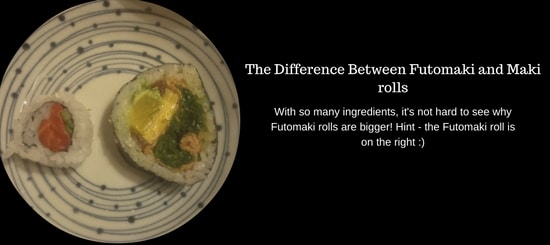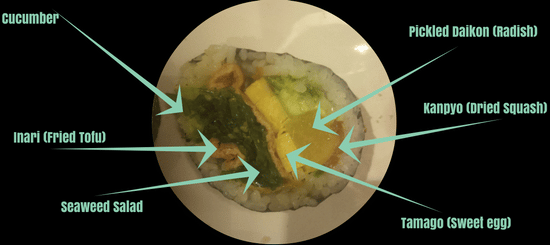Futomaki is a delicious type of Japanese sushi that is very thick. Visually, think of your favorite maki rolls inflated into a jumbo roll! If you don’t have a big mouth, these rolls can get messy, quick. Do yourself a favor and do not try to eat it all in one bite. You will instantly regret it if you are in polite company. Even formal restaurants should ease their sushi etiquette when it comes to this rolls!
Just how much bigger are futomaki rolls? See the difference!

Futomaki is not your average roll! Most sushi rolls have a focus on raw fish. Not futomaki. This roll is known for using cooked ingredients. This makes it a great introductory roll for convincing someone to try out sushi. I find that most of the hesitancy in trying sushi for the first time comes from the idea of eating raw seafood. As long as they can stomach the seaweed wrapped around the roll, they will find it very tasty. If you are new to the wonderful world of sushi, please do visit our page dedicated to sushi and sashimi information.
Futomaki roll ingredients
That’s right, futomaki rolls use mostly cooked ingredients. Common ingredients you will find in a futomaki sushi roll are cooked vegetable such as spinach and cucumber, dried daikon, bamboo shoots, and sometimes shrimp. Futomaki rolls have a wide array of ingredients, and adventurous chefs fill them to the brim with fillings that are normally associated with sushi, such as chopped tuna, but less commonly the rolls are filled with meats such as ribeye. These rolls are most commonly eaten vegetarian and vegan style. Because of the size of these rolls, you need to be very, very careful rolling them. It is also very important to use sushi rice.
Example of Futomaki Ingredients

Futomaki means you can create rolls without sushi grade fish. You can use dried shitake mushrooms or preserved gourds as the main fillings. Unlike many rolls that have only one or two fillings, futomaki rolls are often stuffed full with as many as ten! Expert sushi makers will find the perfect balance of fillings, pairing them to create aesthetically pleasing, palatable dishes. When you have so many different tastes and textures, it is difficult to balance them all. And yet expert chefs do it effortlessly, and some even create patterns such as roses and the rising sun in their chopped rolls using the colors of the ingredients! Creative sushi chefs blend art and food in their approach to these jumbo rolls.
What can you put in a futomaki roll? Here are some ideas to get you started!
Vegetables: Spinach, cucumber, dried daikon, bamboo shoots, simmered gourds
Vegetarian: Tamago, fried bean curd, avocado
Seafood: Chopped Tuna, Shrimp, Seasoned Flaked Codfish
Is Futomaki traditional Japanese sushi?
Yes! Futomaki originated as festival food in Japan. It was not developed in western kitchens, like the California Roll or Alaskan Roll. Take this with a grain of salt, but apparently during the Setsubun festival, partiers would eat entire uncut futomaki rolls! Is is possible that the sushi burrito has its origins in traditional Japanese festivals? While futomaki isn’t what you think of when you think of traditional Japanese sushi, it does have a long history, especially in certain regions.
If you want an inexpensive, filling, and vegetarian friendly option, these rolls are a great choice. It takes all of the worry out of using raw fish out of the equation if you stick to vegetarian options.
I have always been fascinated by the creation and culture of different foods, particularly sushi and sashimi in the modern era of Japanese cuisine. I am a classically trained chef and sushi connoisseur, also having operated a food service company and enjoy investigating and experimenting with food around the world.